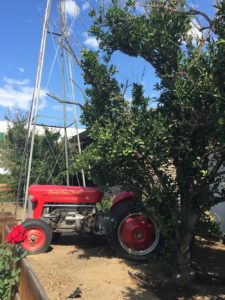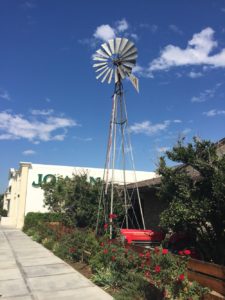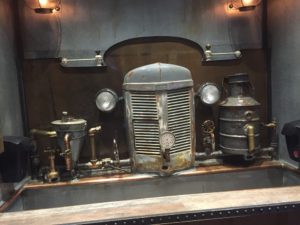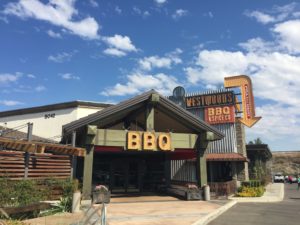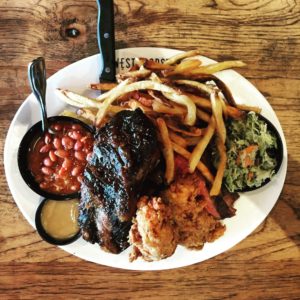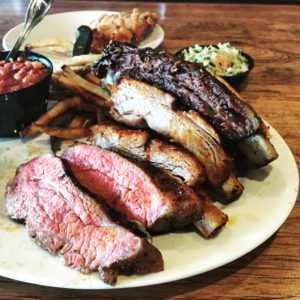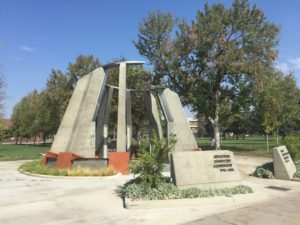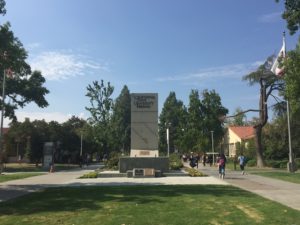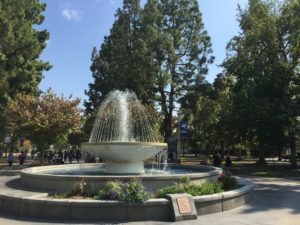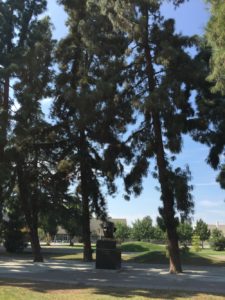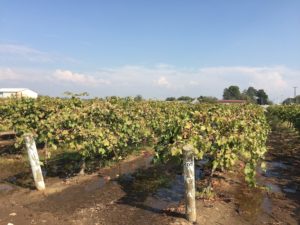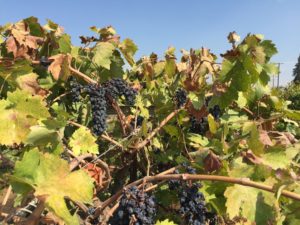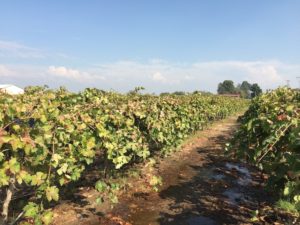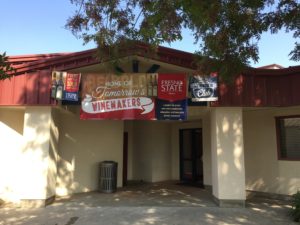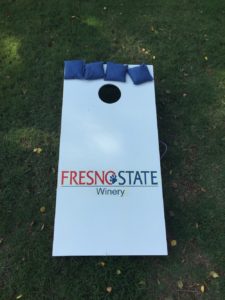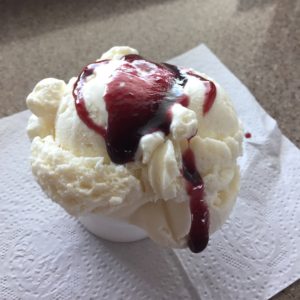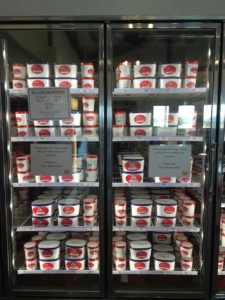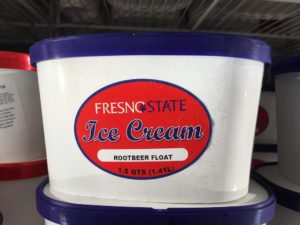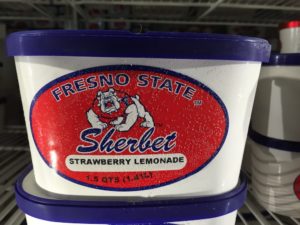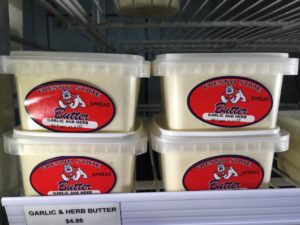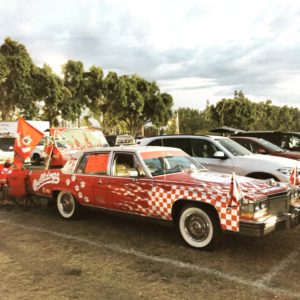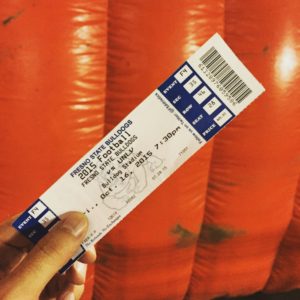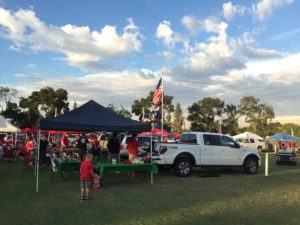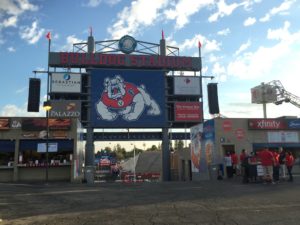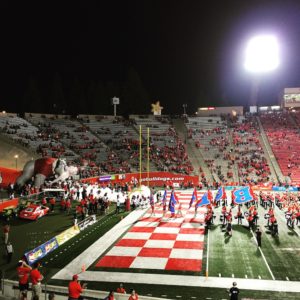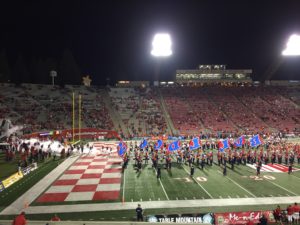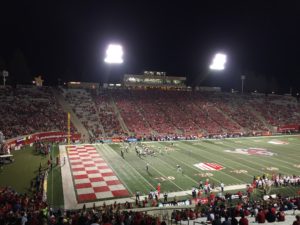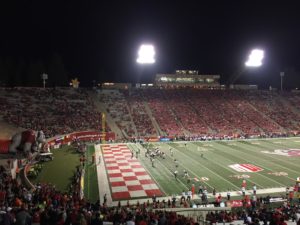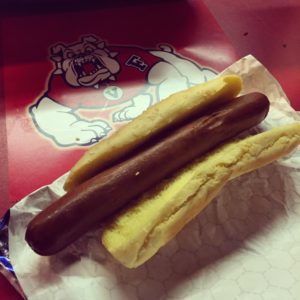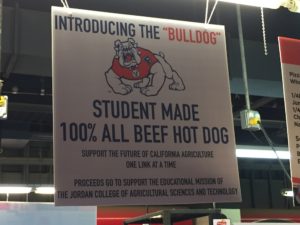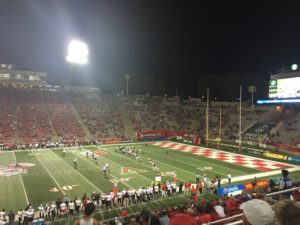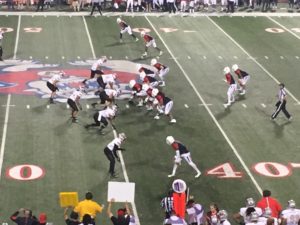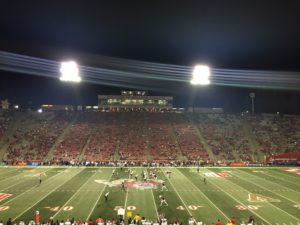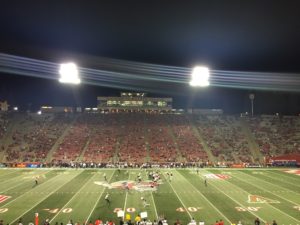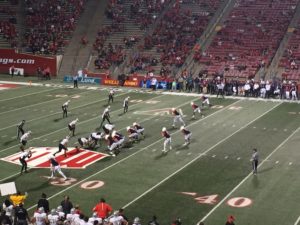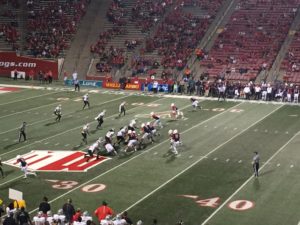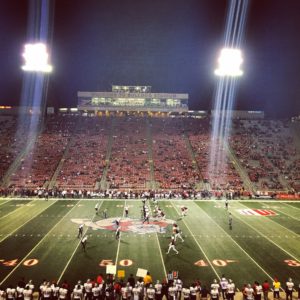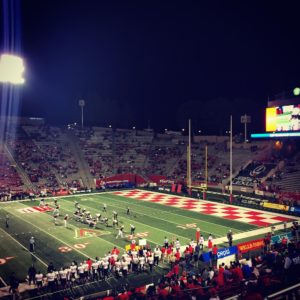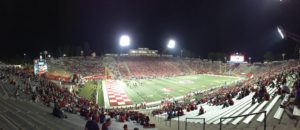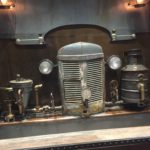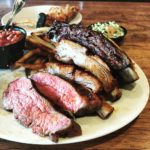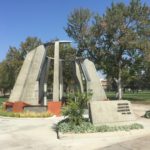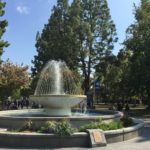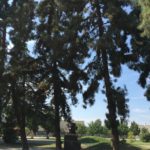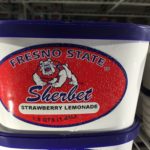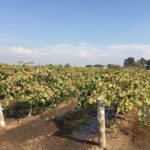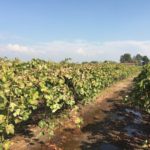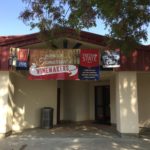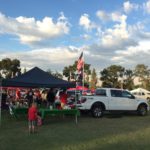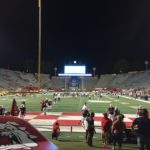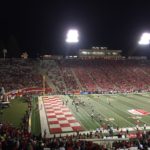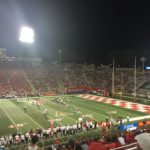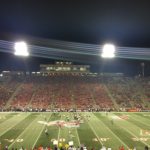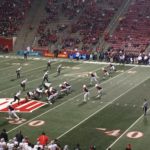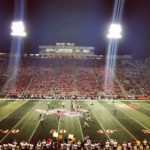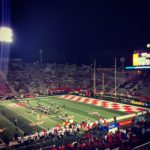Daybreak in Palo Alto finds the pavement slick with a much needed bout of rain the night before. I jump into my rental Kia, set the coordinates into the iPhone, and speed South on route 102 towards Fresno for a Friday night kickoff.
I’m on my way out to Fresno State as the second leg of a west coast triple header, and it’s a three hour jaunt from San Francisco, the nearest city with an international airport. After witnessing a smashmouth Stanford squad lay waste to UCLA the night before, I’m speeding off to the second game of an elusive west coast tripleheader.
I exit route 102 in Gilroy, California home of the infamous Gilroy Garlic Festival, and lope onto the winding stretch of Highway 152 that snakes through the soft, round hills of the Diablo Range. Craggy oak trees, bent and twisted like old scarecrows, dot the hillsides. Gnarled limbs outstretched into great, leafy umbrellas, they form little round pockets of shade that dot the hay colored meadows A few steers peer up from the shelter beneath, their soft eyes obsidian and serene, chomping on mouthfuls of the lush, sweet grass.
Agriculture abounds here, and the roadside is blanketed with fresh produce stands every few hundred yards. Colorful, hand painted signs proffer fresh goods inside the little, ramshackle plywood huts. Overflowing wooden crates of peaches and grapefruits are stacked outside, the plumpest and roundest of them arranged neatly on top. Cartons of strawberries and garlic are set out on makeshift sawhorse tables next to neatly stacked mason jars of fresh olives. Nearby sits a basket full of avocadoes, their leathery skins black in the shade, hawked at six for a buck.
Continuing on past the San Luis reservoir, the road descends from the hills and straightens, bisecting the broad, flat landscape like a black razor. The California Central Valley. Roughly the size of Tennessee, the 450 mile long valley is the largest, most productive agricultural area in the world. It’s estimated that half of U.S. fruit and vegetables are grown here alone, and nearly all of specialty tree crops like almonds, walnuts and olives. Both sides of the highway are flanked by endless rows of nut trees, fruit trees, and grapes; all arranged into neat grids with mechanical precision. Passages from Steinbeck fill my head as I whistle past the groves.
“…And all the time the fruit swells and the flowers break out in long clusters on the vines. And in the growing year the warmth grows and the leaves turn dark green. The prunes lengthen like little green bird’s eggs, and the limbs sag down against the crutches under the weight. And the hard little pears take shape, and the beginning of the fuzz comes out on the peaches. Grape blossoms shed their tiny petals and the hard little beads become green buttons, and the buttons grow heavy. The men who work in the fields, the owners of the little orchards, watch and calculate. The year is heavy with produce. And the men are proud, for of their knowledge they can make the year heavy. They have transformed the world with their knowledge. The short, lean wheat has been made big and productive. Little sour apples have grown large and sweet, and that old grape that grew among the trees and fed the birds its tiny fruit has mothered a thousand varieties, red and black, green and pale pink, purple and yellow; and each variety with its own flavor. The men who work in the experimental farms have made new fruits: nectarines and forty kinds of plums, walnuts with paper shells. And always they work, selecting, grafting, changing, driving themselves, driving the earth to produce.”
The area today is embroiled in a devastating drought. Instead of advertising fruit stands, the medians here are littered with hand painted signs that read something entirely different. Affixed with messages like “pray for rain” or “dams or trains, build water storage now”, the drought is here is palpable, even to the casual observer. A bridge over the Fresno River bed reveals little more than a dry wash of rock and sand, while the green waters of the San Joaquin River flow well below the creek walls, the steep banks parched and crumbling. Given the national dependence on the food supply produced in the Central Valley, this isn’t a California crisis – it’s a national one.
Arriving in Fresno with an appetite, I pull into the Westwoods BBQ company as they’re opening the doors for lunch. The sprawling new building is an homage to nouveau ranch architecture and comes complete with a galvanized tin roof, windmill, and a Massey Ferguson tractor parked out front. A voluminous interior features spectacular exposed timber beams, garage doors, and the rusting remnants of a mechanized planter set out for display alongside a few other artifacts from the regions’ robust agricultural heritage. It’s an admirable attempt at authenticity for a place that sits between a Joanne Fabrics and Chick Fil A.
The waitresses all wear cowboy boots and jean shorts here, and the bubbly blonde taking orders gasps at my four meat combo request of tri-tip beef, beef rib, pork ribs, and fried chicken. By middling California standards, the cue’ is good here, but lacks the smoky punch I’ve come to revere from places in Texas and Kansas City. The ribs (both pork and beef) are prepared well, pulling cleanly from the bone, but lack any actual smoke profile, and likely emerged from an electric job given the hulking size of the kitchen. Tri-tip beef, however, is a clear standout. Delicately pink in the middle, with a crust dusted in an intoxicating dry rub containing notes of garlic and celery, this tri-tip is a fine example of the “Santa Maria” style BBQ indigenous to central California.
I walk off the heavy lunch with a stroll through the Fresno State campus, alive on a pristine Friday afternoon. Skateboarders cruise past on the slick concrete walkways, while a central fountain offers refreshing mist from the high afternoon sun. A few frat house recruiting shacks line the main walkway, the colorful wooden structures decorated with bold Greek letters while the brothers and sisters intercept incoming freshman on the sidewalks. There’s a giant figurehead of Ghandi shaded under a grove of slender pines, while a somber concrete memorial to the Armenian Genocide anchors the other side of campus.
But two of the greatest features to be discovered on the Fresno State campus aren’t on the main quad itself. Instead, it’s a few of the student run agricultural programs that offer their goods to the general public. Boasting the first University run winery in the country, the Fresno State University Winery has been producing student made wines since 1997. Scholars interested in furthering their studies in viticulture and oenology manage everything from the on-site vineyard to the full scale production and aging facilities found on site. The school produces around a dozen different wines, available for purchase in the area, and they have won over 200 medals at wine competitions over the past decade. And lest you think this is simply a major for that perpetually drunk, portly frat boy that everyone knew in college, the Fresno State Wine school boasts a 100% post-graduation employment rate. No word on how many of those esteemed graduates land jobs in the prestigious vineyards of Sonoma or Napa, versus slinging cocktails at the local watering hole, however.
In lieu of the winery, I opt for something a little sweeter for an afternoon treat – ice cream – and I saunter over to the Gibson Farm Market for a few scoops. Like a few other schools I’ve visited, Michigan State and Penn State to name a few, Fresno State also claims its own on campus creamery. Tended by students in the agricultural program, Gibson Farm Market features a vast array meat, dairy and fruit products all produced on the 1,011 acre university farm. Naturally, my eyes gravitate towards the walls of coolers, all of them neatly stacked with dozens of tempting ice cream flavors packed into minimalist white cartons branded with a Bulldog emblem. As if the ice cream itself weren’t enough, with the cornucopia of on campus orchards and fruit groves, the ice cream stand doles out generous portions of student made preserves and jams to sample. In the end, I opt for a simple cup of vanilla, topped with a few viscous spoonful’s of their marionberry preserves.
With the afternoon winding down, I poke my way towards Bulldog Stadium. Scouring the local side streets, all of them affixed with irritating game day parking prohibition ordinances, I’m eventually forced to park at the Wesley United Methodist Church for fifteen bucks. Approaching the stadium, sidewalks swell with red and blue jerseys, and the tailgating lots come to life. Vast swaths of manicured Bermuda grass surround the stadium on both sides, and the lawns are packed with the requisite tents, trucks, and a few custom tailgating jalopies for the die hard fans. There aren’t a lot of street tickets for sale, the market is predictably soft for the 1-5 Bulldogs, but I eventually track one down from a white haired old timer limping towards the stadium clutching a red vinyl Bulldog seat back in tow. His wife doesn’t like the night games he says, and we settle on a final price of $16 because he only has four singles for change.
As the kickoff clock winds down, I find my seat in an empty expanse of the open aluminum bleachers. Massive cantilevered light towers hang over the stands, while the endzones are painted in the iconic red and white checker pattern, the hallmark of Bulldog Stadium. A team of parachutists jump in to deliver the game ball, landing precisely on the menacing open jowls of the Bulldog painted at mid field. Shortly thereafter, the inflatable orange tunnel on the South ramp starts to quake, and the Fresno State squad bounds onto the field, emerging from beneath a giant inflatable Bulldog, enshrouded in a stream of white smoke. Despite the high energy entrance, first half play is relatively quiet. The two squads swap a pair of touchdowns apiece, all of them on long, methodical drives; and the Bulldogs botch a field goal attempt. With the score knotted at 14-14, the two teams retreat to the locker rooms to strategize for the second half.
At halftime, I do some strategizing of my own. I buy a customary stadium Coke for six bucks, and despite having already downed a few pounds of meat and ice cream during the day, my carnivorous instincts are tempted once again by a sign advertising student made hot dogs. In one of the most brilliant stadium concession ideas I’ve encountered, the all-beef dogs proffered in Bulldog Stadium are made entirely by students in the Fresno State Agricultural School, and proceeds from the dogs go towards fundraising for Jordan College of Agricultural Sciences and Technology. So I pony up another six bucks for one of the plump franks, and slather it with a few pumps of mustard.
There is, perhaps, no more appropriate higher educational cause for the PigskinPursuit to support, than the scholastic pursuit of encased meats.
After the break, the Bulldogs dig themselves into the doghouse in the third frame. They fumble the ball to UNLV, botch yet another field goal attempt, and yield two touchdowns to the invading Rebels to trail by 11 heading into the fourth quarter. But then, they do an about face. The defense stiffens, stymieing the Rebel attack while the Bulldog offense breaks through, punching in two touchdowns in quick succession (capped off by a two point conversion) to regain the lead 31-28. The second score, in particular, is a brilliant run by running back Martez Waller that carves the UNLV defense for 38 yards. With 2:37 remaining, the Bulldogs kickoff to the Rebels clutching a tenuous three point margin, the passive Friday night crowd comes to life.
But 2:37 is a lot of time. And on the first play of the ensuing drive from his own 25 yard line, UNLV quarterback Kurt Palandech gashes the UNLV defense, sprinting for 39 yards deep into Bulldog territory before he is finally stopped at the 36 yard line. With two minutes remaining, and only 36 yards to go, it portends heartbreak once again for the Bulldog faithful.
It is precisely at that moment, in the parched Central Valley of California, that the weather gods intervene in spectacular fashion. Just as UNLV huddles for the next play, the night skies open up, and a torrential downpour cascades onto the glowing field below. The drops fall heavy and cool in the tepid night air, liquid patters and chimes on the aluminum benches, the crowd rises and roars like a wilted flower refreshed. Both the ball and the field are immediately slickened, and the Las Vegas natives are ill equipped to deal with such elements. Their offense falters, tattered in the deluge, and they are swept away in four quick plays. The final two are sacks, where the Rebel QB is stuffed ceremoniously into the soggy turf to lie, defeated in a puddle of tears and rain. Dramatically, the Bulldog’s prevail 31-28. God is credited with one assist on the night.
It’s a poetic ending for a game at Fresno State. The garden of America, scorched and cracked, thirsting for a few drops of water. A proud football team, struggling too, in need of a lift of their own. The green “V” on the back of the Bulldog helmets stands for the California Central Valley, the very mission of the school interwoven into the agricultural backbone of the of the state. It was a fitting end, then, that the Bulldogs escaped with a win during my brief visit to Fresno, both the team and the valley quenched by a few precious drops of rain.
footnote: There are two other exceptional eateries to be found in Fresno during a game weekend that are worthy of inclusion for future reference.
- Mike’s Grill – which serves the best Santa Maria style Tri-Tip sandwich that I’ve had anywhere in California, and is found in an unassuming shack in the middle of a strip mall parking lot.
- the Chicken Pie Shop – which specializes in, well, chicken pies and is a unspoiled, beautifully original, green vinyl boothed throwback to the golden age of the american diner.
Full Clickthrough Gallery Below:
Drugs are sumptuous, and definite men cannot get the medicaments they need. Certain drugs are as a rule used to treat varied types of infection caused by definite types of bacteria, such as tonsillitis and infections of the throat. If you’re concerned about sexual problem, you probably know about http://isviagraoverthecounter.com/Male-Enhancement-Pills.html. What are side effects of Cialis? There are varied drugs for male impotence cure. Very likely Male Enhancement Pills Over the Counter is a very complicated topic. More data about Cialis available at best male enhancement pills over the counter. While the generic is credited with improving nausea, it may also kill the mood in bedroom. All kinds of medications, from those that are elaborate ‘all natural’ to those that are chemically produced in a laboratory, may cause some kind of aftereffects.

